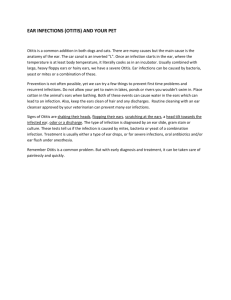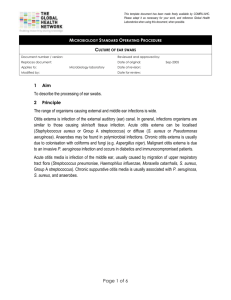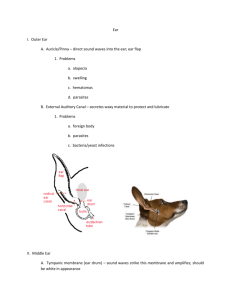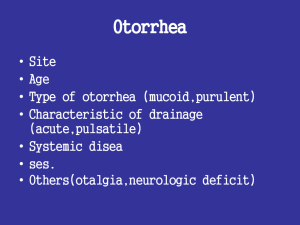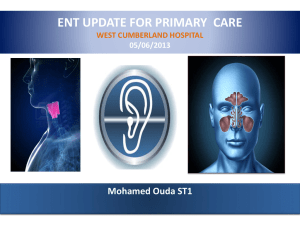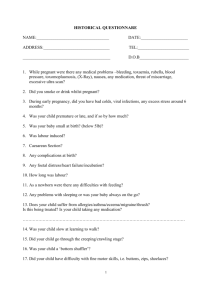B 1i9 June 2014
advertisement
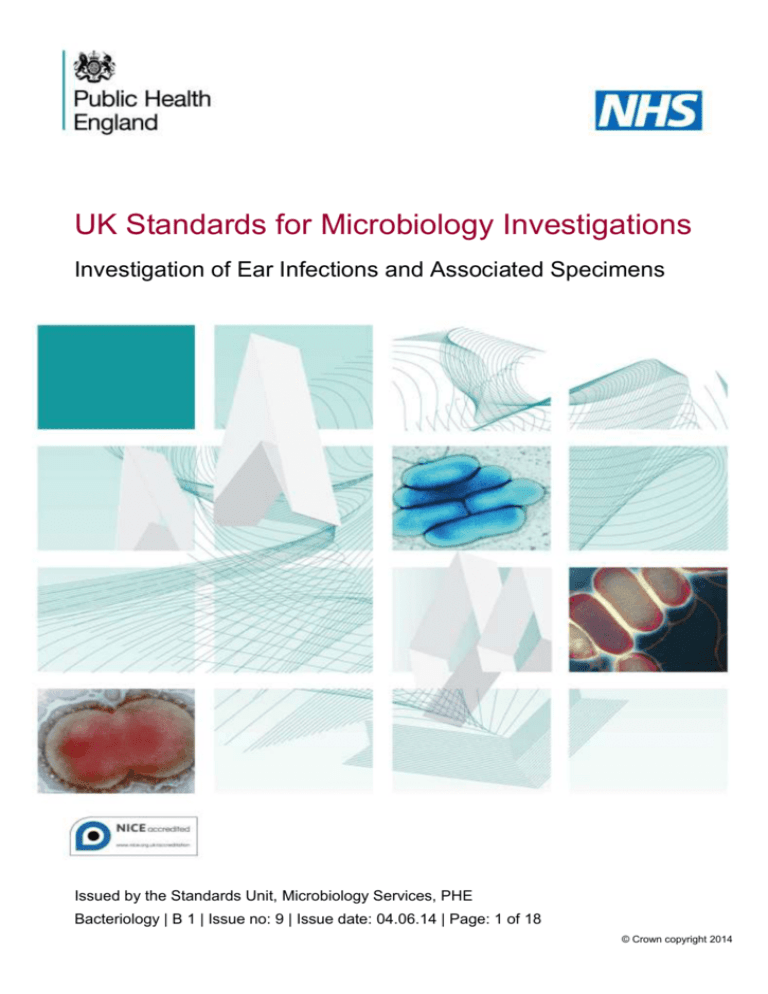
UK Standards for Microbiology Investigations Investigation of Ear Infections and Associated Specimens Issued by the Standards Unit, Microbiology Services, PHE Bacteriology | B 1 | Issue no: 9 | Issue date: 04.06.14 | Page: 1 of 18 © Crown copyright 2014 Investigation of Ear Infections and Associated Specimens Acknowledgments UK Standards for Microbiology Investigations (SMIs) are developed under the auspices of Public Health England (PHE) working in partnership with the National Health Service (NHS), Public Health Wales and with the professional organisations whose logos are displayed below and listed on the website http://www.hpa.org.uk/SMI/Partnerships. SMIs are developed, reviewed and revised by various working groups which are overseen by a steering committee (see http://www.hpa.org.uk/SMI/WorkingGroups). The contributions of many individuals in clinical, specialist and reference laboratories who have provided information and comments during the development of this document are acknowledged. We are grateful to the Medical Editors for editing the medical content. For further information please contact us at: Standards Unit Microbiology Services Public Health England 61 Colindale Avenue London NW9 5EQ E-mail: standards@phe.gov.uk Website: http://www.hpa.org.uk/SMI UK Standards for Microbiology Investigations are produced in association with: Bacteriology | B 1 | Issue no: 9 | Issue date: 04.06.14 | Page: 2 of 18 UK Standards for Microbiology Investigations | Issued by the Standards Unit, Public Health England Investigation of Ear Infections and Associated Specimens Contents ACKNOWLEDGMENTS .......................................................................................................... 2 AMENDMENT TABLE ............................................................................................................. 4 UK SMI: SCOPE AND PURPOSE ........................................................................................... 5 SCOPE OF DOCUMENT ......................................................................................................... 7 INTRODUCTION ..................................................................................................................... 7 TECHNICAL INFORMATION/LIMITATIONS ........................................................................... 8 1 SAFETY CONSIDERATIONS .................................................................................... 10 2 SPECIMEN COLLECTION ......................................................................................... 10 3 SPECIMEN TRANSPORT AND STORAGE ............................................................... 11 4 SPECIMEN PROCESSING/PROCEDURE ................................................................. 11 5 REPORTING PROCEDURE ....................................................................................... 14 6 NOTIFICATION TO PHE OR EQUIVALENT IN THE DEVOLVED ADMINISTRATIONS .................................................................................................. 14 APPENDIX: INVESTIGATION OF EAR SWABS AND ASSOCIATED SPECIMENS ............ 16 REFERENCES ...................................................................................................................... 17 Bacteriology | B 1 | Issue no: 9 | Issue date: 04.06.14 | Page: 3 of 18 UK Standards for Microbiology Investigations | Issued by the Standards Unit, Public Health England Investigation of Ear Infections and Associated Specimens Amendment Table Each SMI method has an individual record of amendments. The current amendments are listed on this page. The amendment history is available from standards@phe.gov.uk. New or revised documents should be controlled within the laboratory in accordance with the local quality management system. Amendment No/Date. 13/04.06.14 Issue no. discarded. 8.4 Insert Issue no. 9 Section(s) involved Amendment Document has been transferred to a new template to reflect the Health Protection Agency’s transition to Public Health England. Front page has been redesigned. Whole document. Status page has been renamed as Scope and Purpose and updated as appropriate. Professional body logos have been reviewed and updated. Standard safety and notification references have been reviewed and updated. Introduction. Specific sections on “Mycotic infections” and “Other Organisms” removed. References. References reviewed and updated. Amendment No/Date. 12/29.03.12 Issue no. discarded. 8.3 Insert Issue no. 8.4 Section(s) involved Amendment Whole document. Document transferred to an updated template. Bacteriology | B 1 | Issue no: 9 | Issue date: 04.06.14 | Page: 4 of 18 UK Standards for Microbiology Investigations | Issued by the Standards Unit, Public Health England Investigation of Ear Infections and Associated Specimens UK SMI: Scope and Purpose Users of SMIs Primarily, SMIs are intended as a general resource for practising professionals operating in the field of laboratory medicine and infection specialties in the UK. SMIs also provide clinicians with information about the available test repertoire and the standard of laboratory services they should expect for the investigation of infection in their patients, as well as providing information that aids the electronic ordering of appropriate tests. The documents also provide commissioners of healthcare services with the appropriateness and standard of microbiology investigations they should be seeking as part of the clinical and public health care package for their population. Background to SMIs SMIs comprise a collection of recommended algorithms and procedures covering all stages of the investigative process in microbiology from the pre-analytical (clinical syndrome) stage to the analytical (laboratory testing) and post analytical (result interpretation and reporting) stages. Syndromic algorithms are supported by more detailed documents containing advice on the investigation of specific diseases and infections. Guidance notes cover the clinical background, differential diagnosis, and appropriate investigation of particular clinical conditions. Quality guidance notes describe laboratory processes which underpin quality, for example assay validation. Standardisation of the diagnostic process through the application of SMIs helps to assure the equivalence of investigation strategies in different laboratories across the UK and is essential for public health surveillance, research and development activities. Equal Partnership Working SMIs are developed in equal partnership with PHE, NHS, Royal College of Pathologists and professional societies. The list of participating societies may be found at http://www.hpa.org.uk/SMI/Partnerships. Inclusion of a logo in an SMI indicates participation of the society in equal partnership and support for the objectives and process of preparing SMIs. Nominees of professional societies are members of the Steering Committee and Working Groups which develop SMIs. The views of nominees cannot be rigorously representative of the members of their nominating organisations nor the corporate views of their organisations. Nominees act as a conduit for two way reporting and dialogue. Representative views are sought through the consultation process. SMIs are developed, reviewed and updated through a wide consultation process. Quality Assurance NICE has accredited the process used by the SMI Working Groups to produce SMIs. The accreditation is applicable to all guidance produced since October 2009. The process for the development of SMIs is certified to ISO 9001:2008. SMIs represent a good standard of practice to which all clinical and public health microbiology laboratories in the UK are expected to work. SMIs are NICE accredited and represent Microbiology is used as a generic term to include the two GMC-recognised specialties of Medical Microbiology (which includes Bacteriology, Mycology and Parasitology) and Medical Virology. Bacteriology | B 1 | Issue no: 9 | Issue date: 04.06.14 | Page: 5 of 18 UK Standards for Microbiology Investigations | Issued by the Standards Unit, Public Health England Investigation of Ear Infections and Associated Specimens neither minimum standards of practice nor the highest level of complex laboratory investigation possible. In using SMIs, laboratories should take account of local requirements and undertake additional investigations where appropriate. SMIs help laboratories to meet accreditation requirements by promoting high quality practices which are auditable. SMIs also provide a reference point for method development. The performance of SMIs depends on competent staff and appropriate quality reagents and equipment. Laboratories should ensure that all commercial and in-house tests have been validated and shown to be fit for purpose. Laboratories should participate in external quality assessment schemes and undertake relevant internal quality control procedures. Patient and Public Involvement The SMI Working Groups are committed to patient and public involvement in the development of SMIs. By involving the public, health professionals, scientists and voluntary organisations the resulting SMI will be robust and meet the needs of the user. An opportunity is given to members of the public to contribute to consultations through our open access website. Information Governance and Equality PHE is a Caldicott compliant organisation. It seeks to take every possible precaution to prevent unauthorised disclosure of patient details and to ensure that patient-related records are kept under secure conditions. The development of SMIs are subject to PHE Equality objectives http://www.hpa.org.uk/webc/HPAwebFile/HPAweb_C/1317133470313. The SMI Working Groups are committed to achieving the equality objectives by effective consultation with members of the public, partners, stakeholders and specialist interest groups. Legal Statement Whilst every care has been taken in the preparation of SMIs, PHE and any supporting organisation, shall, to the greatest extent possible under any applicable law, exclude liability for all losses, costs, claims, damages or expenses arising out of or connected with the use of an SMI or any information contained therein. If alterations are made to an SMI, it must be made clear where and by whom such changes have been made. The evidence base and microbial taxonomy for the SMI is as complete as possible at the time of issue. Any omissions and new material will be considered at the next review. These standards can only be superseded by revisions of the standard, legislative action, or by NICE accredited guidance. SMIs are Crown copyright which should be acknowledged where appropriate. Suggested Citation for this Document Public Health England. (2014). Investigation of Ear Infections and Associated Specimens. UK Standards for Microbiology Investigations. B 1 Issue 9. http://www.hpa.org.uk/SMI/pdf Bacteriology | B 1 | Issue no: 9 | Issue date: 04.06.14 | Page: 6 of 18 UK Standards for Microbiology Investigations | Issued by the Standards Unit, Public Health England Investigation of Ear Infections and Associated Specimens Scope of Document Type of Specimen Ear swab, middle ear effusion For investigation of fungal infection, scrapings of material from the ear canal are preferred although swabs can also be used. Scope This document describes the bacteriological and mycological investigation of ear swabs and associated specimens. This SMI should be used in conjunction with other SMIs. Introduction Otitis Externa1,2 In general, infection of the external auditory canal resembles infection of skin and soft tissue elsewhere. However, there are some notable differences. The canal is narrow and, as a result, foreign materials and fluid that enter can become trapped, causing irritation and maceration of the superficial tissues. Otitis externa can be subdivided into categories: acute localised; acute diffuse; chronic; and invasive (‘malignant’). However, except for invasive, they are rarely differentiated as such in clinical practice. Acute localised otitis externa Acute localised otitis externa is usually caused by Staphylococcus aureus and may result in a furuncle or pustule of a hair follicle. Erysipelas due to Group A Streptococcus may be found in the concha and canal. Acute diffuse otitis externa Acute diffuse otitis externa is a common disease in adults with frequent recurrence of infections. It is also known as "swimmer's ear” and is mainly encountered in hot, humid conditions. Many different bacteria cause this infection, the most common being Pseudomonas aeruginosa and S. aureus. Anaerobes are frequently associated with polymicrobial infections. Anaerobes involved in ear infections usually originate from the oropharynx. Chronic otitis externa Chronic otitis externa is due to colonisation with Enterobacteriaceae and fungi best treated by topical cleansing, and not with antibiotics. Malignant otitis externa Clinically the most important condition to identify is invasive (‘malignant’) otitis externa. Malignant otitis externa is a severe necrotising infection that spreads from the squamous epithelium of the canal into surrounding soft tissues, blood vessels, cartilage and bone. Patients at risk include people with diabetes, the elderly and patients who are immunocompromised. It is a life-threatening condition with significant risk of neurological involvement and facial nerve paralysis. It is almost always caused by P. aeruginosa. Bacteriology | B 1 | Issue no: 9 | Issue date: 04.06.14 | Page: 7 of 18 UK Standards for Microbiology Investigations | Issued by the Standards Unit, Public Health England Investigation of Ear Infections and Associated Specimens Otitis Media3 Otitis media covers a broad spectrum of disease, which includes acute otitis media and chronic suppurative otitis media, both these conditions are covered in more detail below. Although uncommon in adults, the causative organisms and treatment of otitis media are the same as in children. As uptake of the pneumococcal vaccination has become more widespread the causative organisms for this condition have changed 4. An external ear swab is not useful in the investigation of otitis media unless there is perforation of the eardrum. Tympanocentesis, to sample middle ear effusion, is rarely justified. Acute otitis media4 Acute otitis media infection is defined by the co-existence of fluid in the middle ear and signs and symptoms of acute illness. It occurs when oropharyngeal flora ascend the eustachian tube and are not eliminated by the defence mechanisms of the middle ear. Organisms that cause this type of infection are Streptococcus pneumoniae, Haemophilus influenza and Moraxella catarrhalis. Less frequent causes are Streptococcus pyogenes, S. aureus, and Gram negative bacilli. Respiratory viruses have been isolated and have a role in the aetiology of otitis media especially in children5. Chronic suppurative otitis media4 Chronic suppurative infections are very destructive, persistent and can produce irreversible adverse outcomes such as hearing loss. The most common bacterial isolates are pseudomonads closely followed by meticillin resistant Staphylococcus aureus (MRSA), with anerobic bacteria found in 25% of patients. P. aeruginosa usually only colonises the ear canal and is rarely isolated from the middle ear. Technical Information/Limitations Limitations of UK SMIs The recommendations made in UK SMIs are based on evidence (eg sensitivity and specificity) where available, expert opinion and pragmatism, with consideration also being given to available resources. Laboratories should take account of local requirements and undertake additional investigations where appropriate. Prior to use, laboratories should ensure that all commercial and in-house tests have been validated and are fit for purpose. Selective Media in Screening Procedures Selective media which does not support the growth of all circulating strains of organisms may be recommended based on the evidence available. A balance therefore must be sought between available evidence, and available resources required if more than one media plate is used. Specimen Containers6,7 SMIs use the term “CE marked leak proof container” to describe containers bearing the CE marking used for the collection and transport of clinical specimens. The requirements for specimen containers are given in the EU in vitro Diagnostic Medical Devices Directive (98/79/EC Annex 1 B 2.1) which states: “The design must allow Bacteriology | B 1 | Issue no: 9 | Issue date: 04.06.14 | Page: 8 of 18 UK Standards for Microbiology Investigations | Issued by the Standards Unit, Public Health England Investigation of Ear Infections and Associated Specimens easy handling and, where necessary, reduce as far as possible contamination of, and leakage from, the device during use and, in the case of specimen receptacles, the risk of contamination of the specimen. The manufacturing processes must be appropriate for these purposes”. Bacteriology | B 1 | Issue no: 9 | Issue date: 04.06.14 | Page: 9 of 18 UK Standards for Microbiology Investigations | Issued by the Standards Unit, Public Health England Investigation of Ear Infections and Associated Specimens 1 Safety Considerations6-22 1.1 Specimen Collection, Transport and Storage6-11 Use aseptic technique. Collect specimens in appropriate CE marked leak proof containers and transport in sealed plastic bags. Collect swabs into appropriate transport medium and transport medium in sealed plastic bags. For investigation of fungal infection, use an appropriate method to transport scrapings of material from the ear canal. Compliance with postal, transport and storage regulations is essential. 1.2 Specimen Processing6-22 Containment Level 2. Laboratory procedures that give rise to infectious aerosols must be conducted in a microbiological safety cabinet14. Refer to current guidance on the safe handling of all organisms documented in this SMI. The above guidance should be supplemented with local COSHH and risk assessments. 2 Specimen Collection 2.1 Type of Specimens Ear swab, middle ear effusion 2.2 Optimal Time and Method of Collection For safety considerations refer to Section 1.1. Unless otherwise stated, swabs for bacterial and fungal culture should then be placed in appropriate transport medium23-27. Swab any pus or exudates. For investigation of fungal infection, scrapings of material from the ear canal are preferred although swabs can also be used. Collect specimens other than swabs into appropriate CE marked leakproof containers and place in sealed plastic bags. 2.3 Adequate Quantity and Appropriate Number of Specimens28 Numbers and frequency of specimen collection are dependent on clinical condition of patient. Bacteriology | B 1 | Issue no: 9 | Issue date: 04.06.14 | Page: 10 of 18 UK Standards for Microbiology Investigations | Issued by the Standards Unit, Public Health England Investigation of Ear Infections and Associated Specimens 3 Specimen Transport and Storage6,7 3.1 Optimal Transport and Storage Conditions Collect specimens before antimicrobial therapy where possible28. Specimens should be transported and processed as soon as possible 28. If processing is delayed, refrigeration is preferable to storage at ambient temperature. 4 Specimen Processing/Procedure6,7 4.1 Test Selection N/A 4.2 Appearance N/A 4.3 Sample Preparation N/A 4.4 Microscopy 4.4.1 Standard (Refer to TP 39 – Staining Procedures) Gram stained smear if middle ear effusion is sent. Using a sterile pipette place one drop of fluid on a clean microscope slide. Spread this with a sterile loop to make a thin smear for Gram staining. 4.5 Culture and Investigation Swabs Inoculate each agar plate with swab (refer to Q 5 - Inoculation of Culture Media for Bacteriology). For the isolation of individual colonies, spread inoculum with a sterile loop. Swabs taken from the nasopharynx for diagnosis of ear infections are inappropriate and should be discarded according to local protocols. Middle ear effusion Using a sterile pipette inoculate each agar plate with specimen (refer to Q 5 Inoculation of Culture Media for Bacteriology). For the isolation of individual colonies, spread inoculum with a sterile loop. Bacteriology | B 1 | Issue no: 9 | Issue date: 04.06.14 | Page: 11 of 18 UK Standards for Microbiology Investigations | Issued by the Standards Unit, Public Health England Investigation of Ear Infections and Associated Specimens 4.5.1 Culture media, conditions and organisms Clinical details/ Specimen Standard media conditions Otitis externa All swabs Chocolate agar with bacitracin* Incubation Temp °C Atmos Time 35-37 5-10 % CO2 40-48hr Cultures read Target organism(s) daily H. influenzae M. catarrhalis Otitis media S. pneumoniae Other organisms in pure growth may be significant Staph/strep selective agar 35-37 air 40-48hr daily Lancefield group A streptococcus S. aureus Middle ear effusion Clinical details/ Middle ear effusion Specimen Neomycin fastidious anaerobe agar with metronidazole 5µg disc** 35-37 anaero bic 48hr 40hr Anaerobes29 CLED or MacConkey agar 35-37 air 16-24hr 16hr Enterobacteriaceae Sabouraud agar 35-37 air 40-48hr† 40hr Fungi Chocolate agar 35-37 5-10 % CO2 40-48hr daily Any organism Fastidious anaerobe agar with metronidazole 5µg disc 35-37 anaero bic 7-14d 40hr Anaerobes29 Optional media Incubation Cultures read Target organism(s) daily M. catarrhalis conditions See* All swabs Blood agar Pseudomonads Temp °C Atmos Time 35-37 5-10% CO2 40-48hr Otitis externa S. pneumoniae Otitis media *may include either a bacitracin 10 unit disc or bacitracin incorporated in the agar 30. When bacitracin is incorporated in to the plate a separate blood agar plate will need to be put up to detect M. catarrhalis and S. pneumonia. ** this should be done for Otitis media cases only. Note: if chocolate agar with bacitracin incorporated into the agar is used then blood agar incubated in 5-10% CO2 must be included for the isolation of M. catarrhalis and S. pneumoniae. †incubation may be extended to 5 days. In such cases plates should be read at 40hr and then left in the incubator/cabinet until day 5. Certain opportunistic pathogens will require extended incubation. In patients coming from endemic regions a tuberculous granuloma of the middle ear should be considered and Bacteriology | B 1 | Issue no: 9 | Issue date: 04.06.14 | Page: 12 of 18 UK Standards for Microbiology Investigations | Issued by the Standards Unit, Public Health England Investigation of Ear Infections and Associated Specimens appropriate cultures set up see B 40 – Investigation of Specimens for Mycobacterium species. 4.6 Identification Refer to individual SMIs for organism identification. 4.6.1 Minimum level of identification in the laboratory Anaerobes "anaerobes" level or mixed “anaerobes” level Enterobacteriaceae "coliform" level Fungi genus level H. influenzae species level -haemolytic streptococci Lancefield group level M. catarrhalis species level Neisseria species level Pseudomonas species "pseudomonads" level S. aureus species level S. pneumoniae species level Yeasts "yeasts" level Organisms may be further identified if this is clinically or epidemiologically indicated. 4.7 Antimicrobial Susceptibility Testing Refer to British Society for Antimicrobial Chemotherapy (BSAC) and/or EUCAST guidelines. 4.8 Referral for Outbreak Investigations N/A 4.9 Referral to Reference Laboratories For information on the tests offered, turn around times, transport procedure and the other requirements of the reference laboratory click here for user manuals and request forms. Organisms with unusual or unexpected resistance, and whenever there is a laboratory or clinical problem, or anomaly that requires elucidation should be sent to the appropriate reference laboratory. Contact appropriate devolved national reference laboratory for information on the tests available, turn around times, transport procedure and any other requirements for sample submission: England and Wales http://www.hpa.org.uk/webw/HPAweb&Page&HPAwebAutoListName/Page/11583134 34370?p=1158313434370 Scotland http://www.hps.scot.nhs.uk/reflab/index.aspx Bacteriology | B 1 | Issue no: 9 | Issue date: 04.06.14 | Page: 13 of 18 UK Standards for Microbiology Investigations | Issued by the Standards Unit, Public Health England Investigation of Ear Infections and Associated Specimens Northern Ireland http://www.publichealth.hscni.net/directorate-public-health/health-protection 5 Reporting Procedure 5.1 Microscopy Middle ear effusion, report on WBCs and organisms detected. 5.1.1 Microscopy reporting time Urgent microscopy results to be telephoned or sent electronically when available. Written report, 16–72hr. 5.2 Culture Report clinically significant organisms isolated or Report other growth, eg no significant growth or Report absence of growth. 5.2.1 Culture reporting time Clinically urgent culture results to be telephoned or sent electronically when available. Written report, 16–72hr stating, if appropriate, that a further report will be issued. 5.3 Antimicrobial Susceptibility Testing Report susceptibilities as clinically indicated. Prudent use of antimicrobials according to local and national protocols is recommended. 6 Notification to PHE31,32 or Equivalent in the Devolved Administrations33-36 The Health Protection (Notification) regulations 2010 require diagnostic laboratories to notify Public Health England (PHE) when they identify the causative agents that are listed in Schedule 2 of the Regulations. Notifications must be provided in writing, on paper or electronically, within seven days. Urgent cases should be notified orally and as soon as possible, recommended within 24 hours. These should be followed up by written notification within seven days. For the purposes of the Notification Regulations, the recipient of laboratory notifications is the local PHE Health Protection Team. If a case has already been notified by a registered medical practitioner, the diagnostic laboratory is still required to notify the case if they identify any evidence of an infection caused by a notifiable causative agent. Notification under the Health Protection (Notification) Regulations 2010 does not replace voluntary reporting to PHE. The vast majority of NHS laboratories voluntarily report a wide range of laboratory diagnoses of causative agents to PHE and many PHE Health protection Teams have agreements with local laboratories for urgent reporting of some infections. This should continue. Bacteriology | B 1 | Issue no: 9 | Issue date: 04.06.14 | Page: 14 of 18 UK Standards for Microbiology Investigations | Issued by the Standards Unit, Public Health England Investigation of Ear Infections and Associated Specimens Note: The Health Protection Legislation Guidance (2010) includes reporting of Human Immunodeficiency Virus (HIV) & Sexually Transmitted Infections(STIs), Healthcare Associated Infections (HCAIs) and Creutzfeldt–Jakob disease (CJD) under ‘Notification Duties of Registered Medical Practitioners’: it is not noted under ‘Notification Duties of Diagnostic Laboratories’. http://www.hpa.org.uk/Topics/InfectiousDiseases/InfectionsAZ/HealthProtectionRegula tions Other arrangements exist in Scotland33,34, Wales35 and Northern Ireland36. Bacteriology | B 1 | Issue no: 9 | Issue date: 04.06.14 | Page: 15 of 18 UK Standards for Microbiology Investigations | Issued by the Standards Unit, Public Health England Investigation of Ear Infections and Associated Specimens Appendix: Investigation of Ear Swabs and Associated Specimens Prepare specimens All swabs Otitis externa Otitis media Chocolate agar with bacitracin may include either a bacitracin 10 unit disc or bacitracin incorporated in the agar Incubate at: 35-37°C 5-10% CO2 40-48hr Read daily Staph/Strep selective agar Incubate at: 35-37°C Air 40-48hr Read daily Middle ear effusion CLED or MacConkey agar Sabouraud agar Incubate at: 35-37°C Air 16-24hr Read ≥ 16hr Incubate at: 35-37°C Air 40-48hr* Read ≥ 40hr Neomycin fastidious anaerobe agar with metronidazole 5mg disc Incubate at: 35-37°C Anaerobic 40-48hr Read ≥ 40hr Chocolate agar Incubate at: 35-37°C 5-10% CO2 40-48hr Read daily Fastidious anaerobe agar with metronidazole 5mg disc Incubate at: 35-37°C Anaerobic 7-14d Read ≥ 40hr Optional media to be used if including bacitracin in to chocolate plate Blood agar Incubate at: 35-37°C 5-10% CO2 40-48hr Read daily H. influenza refer to ID 12 M.catarrhalis refer to ID 11 S. pneumoniae refer to ID 4 Other organisms in pure culture may be significant refer to appropriate IDs Lancefield group A streptococcus refer to ID 4 S. aureus refer to ID 7 Enterobacteriaceae refer to ID 16 Pseudomonads refer to ID 17 Fungi Anaerobes refer to ID 8 ID 14 ID 15 ID 25 Any organism refer to appropriate IDs *Incubation may be extended to 5 days. In such cases plates should be read at ³ 40hr and then left in the incubator / cabinet until day 5. Bacteriology | B 1 | Issue no: 9 | Issue date: 04.06.14 | Page: 16 of 18 UK Standards for Microbiology Investigations | Issued by the Standards Unit, Public Health England Anaerobes refer to ID 8 ID 14 ID 15 ID 25 M.catarrhalis refer to ID 11 S. pneumoniae refer to ID 4 Investigation of Ear Infections and Associated Specimens References 1. Geyer M, Howell-Jones R, Cunningham R, McNulty C. Consensus of microbiology reporting of ear swab results to primary care clinicians in patients with otitis externa. Br J Biomed Sci 2011;68:17480. 2. Narayan S, Swift A. Otitis externa: a clinical review. Br J Hosp Med (Lond) 2011;72:554-8. 3. Gould JM, Matz PS. Otitis media. Pediatr Rev 2010;31:102-16. 4. Cunningham M, Guardiani E, Kim HJ, Brook I. Otitis media. Future Microbiol 2012;7:733-53. 5. Wald ER. Acute otitis media and acute bacterial sinusitis. Clin Infect Dis 2011;52 Suppl 4:S277S283. 6. European Parliament. UK Standards for Microbiology Investigations (SMIs) use the term "CE marked leak proof container" to describe containers bearing the CE marking used for the collection and transport of clinical specimens. The requirements for specimen containers are given in the EU in vitro Diagnostic Medical Devices Directive (98/79/EC Annex 1 B 2.1) which states: "The design must allow easy handling and, where necessary, reduce as far as possible contamination of, and leakage from, the device during use and, in the case of specimen receptacles, the risk of contamination of the specimen. The manufacturing processes must be appropriate for these purposes". 7. Official Journal of the European Communities. Directive 98/79/EC of the European Parliament and of the Council of 27 October 1998 on in vitro diagnostic medical devices. 7-12-1998. p. 1-37. 8. Health and Safety Executive. Safe use of pneumatic air tube transport systems for pathology specimens. 9/99. 9. Department for transport. Transport of Infectious Substances, 2011 Revision 5. 2011. 10. World Health Organization. Guidance on regulations for the Transport of Infectious Substances 2013-2014. 2012. 11. Home Office. Anti-terrorism, Crime and Security Act. 2001 (as amended). 12. Advisory Committee on Dangerous Pathogens. The Approved List of Biological Agents. Health and Safety Executive. 2013. p. 1-32 13. Advisory Committee on Dangerous Pathogens. Infections at work: Controlling the risks. Her Majesty's Stationery Office. 2003. 14. Advisory Committee on Dangerous Pathogens. Biological agents: Managing the risks in laboratories and healthcare premises. Health and Safety Executive. 2005. 15. Advisory Committee on Dangerous Pathogens. Biological Agents: Managing the Risks in Laboratories and Healthcare Premises. Appendix 1.2 Transport of Infectious Substances Revision. Health and Safety Executive. 2008. 16. Centers for Disease Control and Prevention. Guidelines for Safe Work Practices in Human and Animal Medical Diagnostic Laboratories. MMWR Surveill Summ 2012;61:1-102. 17. Health and Safety Executive. Control of Substances Hazardous to Health Regulations. The Control of Substances Hazardous to Health Regulations 2002. 5th ed. HSE Books; 2002. Bacteriology | B 1 | Issue no: 9 | Issue date: 04.06.14 | Page: 17 of 18 UK Standards for Microbiology Investigations | Issued by the Standards Unit, Public Health England Investigation of Ear Infections and Associated Specimens 18. Health and Safety Executive. Five Steps to Risk Assessment: A Step by Step Guide to a Safer and Healthier Workplace. HSE Books. 2002. 19. Health and Safety Executive. A Guide to Risk Assessment Requirements: Common Provisions in Health and Safety Law. HSE Books. 2002. 20. Health Services Advisory Committee. Safe Working and the Prevention of Infection in Clinical Laboratories and Similar Facilities. HSE Books. 2003. 21. British Standards Institution (BSI). BS EN12469 - Biotechnology - performance criteria for microbiological safety cabinets. 2000. 22. British Standards Institution (BSI). BS 5726:2005 - Microbiological safety cabinets. Information to be supplied by the purchaser and to the vendor and to the installer, and siting and use of cabinets. Recommendations and guidance. 24-3-2005. p. 1-14 23. Rishmawi N, Ghneim R, Kattan R, Ghneim R, Zoughbi M, Abu-Diab A, et al. Survival of fastidious and nonfastidious aerobic bacteria in three bacterial transport swab systems. J Clin Microbiol 2007;45:1278-83. 24. Barber S, Lawson PJ, Grove DI. Evaluation of bacteriological transport swabs. Pathology 1998;30:179-82. 25. Van Horn KG, Audette CD, Sebeck D, Tucker KA. Comparison of the Copan ESwab system with two Amies agar swab transport systems for maintenance of microorganism viability. J Clin Microbiol 2008;46:1655-8. 26. Nys S, Vijgen S, Magerman K, Cartuyvels R. Comparison of Copan eSwab with the Copan Venturi Transystem for the quantitative survival of Escherichia coli, Streptococcus agalactiae and Candida albicans. Eur J Clin Microbiol Infect Dis 2010;29:453-6. 27. Tano E, Melhus A. Evaluation of three swab transport systems for the maintenance of clinically important bacteria in simulated mono- and polymicrobial samples. APMIS 2011;119:198-203. 28. Baron EJ, Miller JM, Weinstein MP, Richter SS, Gilligan PH, Thomson RB, Jr., et al. A Guide to Utilization of the Microbiology Laboratory for Diagnosis of Infectious Diseases: 2013 Recommendations by the Infectious Diseases Society of America (IDSA) and the American Society for Microbiology (ASM). Clin Infect Dis 2013;57:e22-e121. 29. Jousimies-Somer H, Summanen P, Citron D. Advanced Identification Methods. Anaerobic Bacteriology Manual. 6th ed. Star Publishing Company; 2002. p. 104. 30. Nye KJ, Fallon D, Gee B, Howe S, Messer S, Turner T, et al. A comparison of the performance of bacitracin-incorporated chocolate blood agar with chocolate blood agar plus a bacitracin disk in the isolation of Haemophilus influenzae from sputum. J Med Microbiol 2001;50:472-5. 31. Public Health England. Laboratory Reporting to Public Health England: A Guide for Diagnostic Laboratories. 2013. p. 1-37. 32. Department of Health. Health Protection Legislation (England) Guidance. 2010. p. 1-112. 33. Scottish Government. Public Health (Scotland) Act. 2008 (as amended). 34. Scottish Government. Public Health etc. (Scotland) Act 2008. Implementation of Part 2: Notifiable Diseases, Organisms and Health Risk States. 2009. 35. The Welsh Assembly Government. Health Protection Legislation (Wales) Guidance. 2010. 36. Home Office. Public Health Act (Northern Ireland) 1967 Chapter 36. 1967 (as amended). Bacteriology | B 1 | Issue no: 9 | Issue date: 04.06.14 | Page: 18 of 18 UK Standards for Microbiology Investigations | Issued by the Standards Unit, Public Health England
